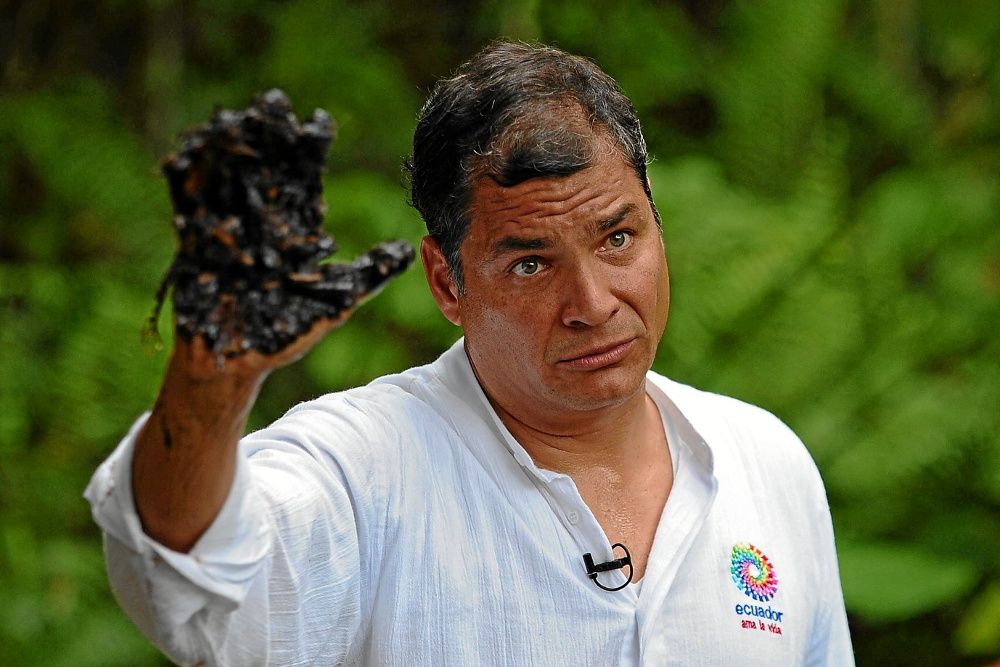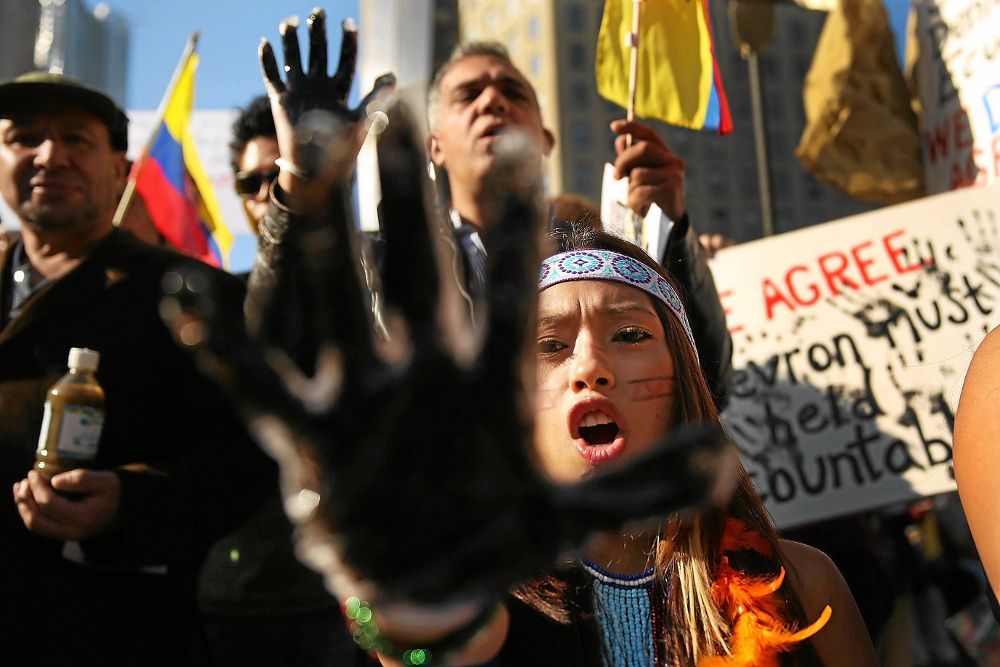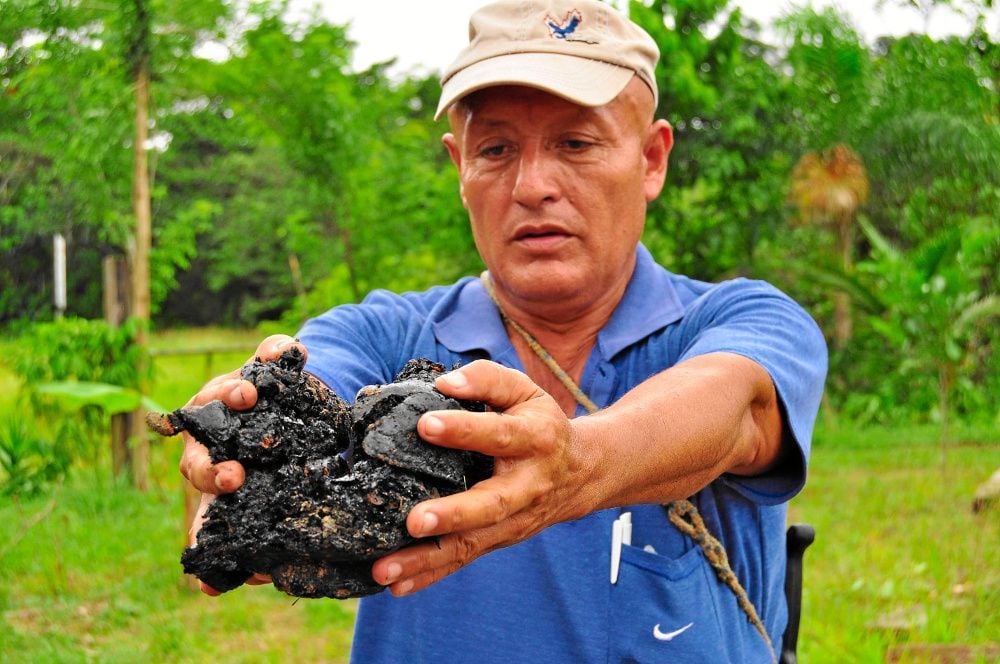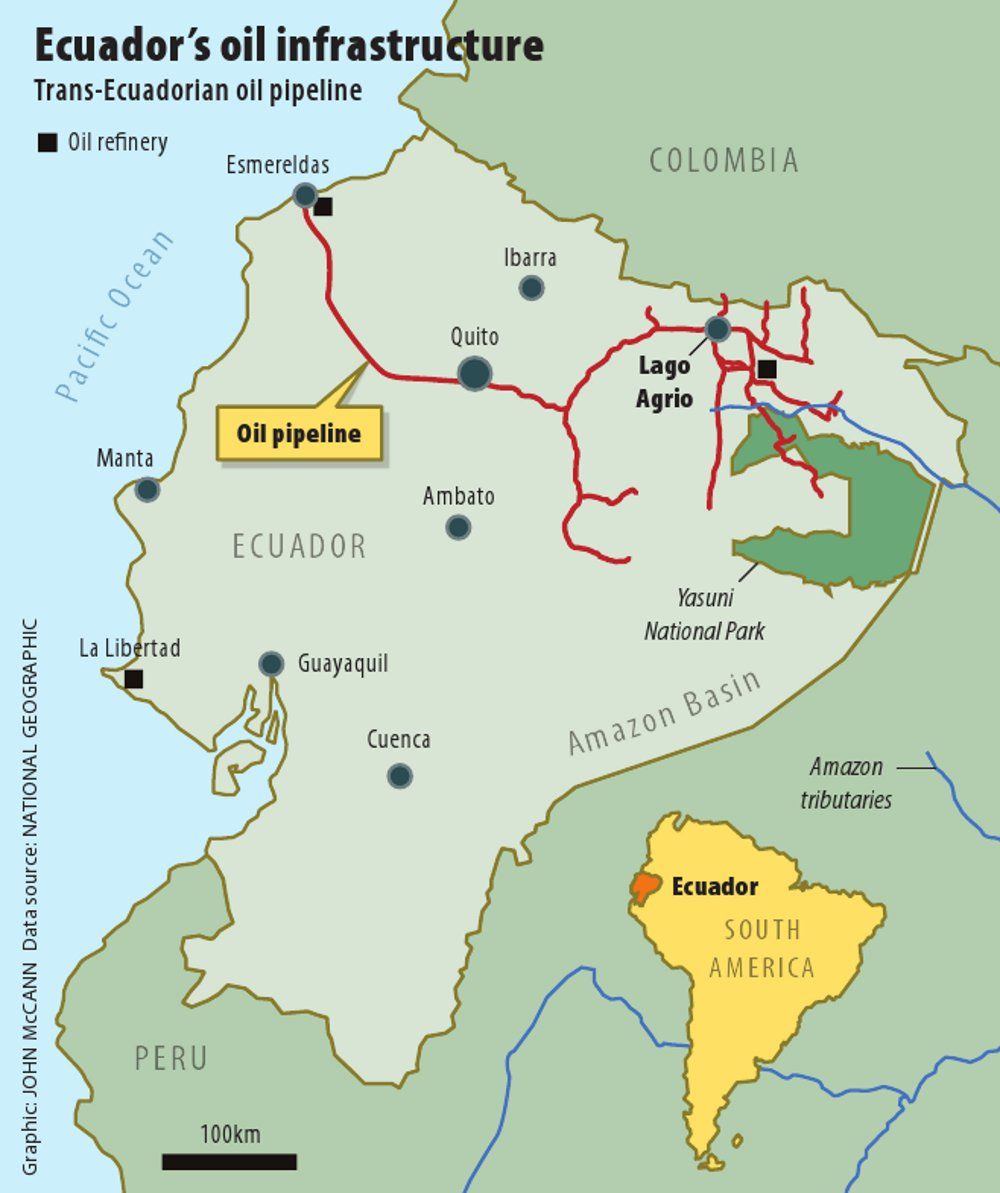It is 35° and the 80% humidity is making it hard to hold my pen properly as I take notes. Sweat is instantaneous. It is late January, and on the makeshift stage in front of me, Mia Farrow, the Hollywood star and humanitarian, is denouncing American oil company Texaco – now owned by Chevron, the US's third-largest corporation – for causing environmental pollution at an oil field she has just toured.
Leading questions are being asked by a few dozen Ecuadorian journalists, each one trying to get Farrow to say the most damning thing possible about the company, which operated here for three decades until 1992.
We are in a clearing in the jungle that has been transformed with the addition of the stage and portable toilets. The hum of a generator drowns out the deafening sound of the forest, normally a cacophony of shrill hoots and squawks from birds. The only obvious sign of oil drilling is a closed oil well in the middle of the clearing.
Farrow has just finished a carefully orchestrated public relations exercise, having been shown around one of the several hundred pits that Texaco is alleged to have dug next to its oil rigs to store what is known in the oil industry as "produced water".
This water – a by-product of drilling – is brought to the surface along with the oil and gas. The United States Environmental Protection Agency says that it usually contains carcinogens and is linked to defects in children and cancer.
This particular oil field is a two-hour drive from the provincial capital of Lago Agrio (Bitter Lake), a nod from the oil workers who founded it to Texaco's home in Sour Lake in the US. It is also known as Nueva Loja by locals, after the southern province of Loja, which many of them left behind for the oil boom.
Rundown town
The town exploded when Texaco spread into the seemingly impenetrable jungle around it. Now, it looks tired and worn with age, as paint slowly strips off the buildings. A nearby military base stands guard against groups from Colombia, 10km away, who find refuge from its army in the border zone.
Farrow's tour comes with its own military escort, and a pair of yellow boots to help her to navigate the muddy jungle path around an oil well. Bugs swirl in the still and sticky air, as the journalists jostle to try to get a better view of her reaction as she is shown how oil has infiltrated everything.
The dark red and brown earth has been tainted with black oil. The mud, when it rains, is treacherous, and feet can quickly disappear into the quagmire with a missed step. A machete chop from one of the guides through a Carludovica palm (the material for the famous Panama hats) causes oil to weep from its fibres.
"The plants that survive here are the ones that can absorb the crude and process it, because in small amounts it is biodegradable," says Paola Carrera, from the Ecuadorian environment department.
The tour ends with Farrow balancing on several tree trunks stretched across an oil well. Because of its viscosity, it can hold the weight of a person if the weight is evenly spaced. The final objective of the tour is to bury a glove-covered hand in the black oil residue and raise it to the hungry cameras.

President Rafael Correa reveals the 'dirty hand of Chevron'. (AFP)
Ecuador's new and revolutionary president, Rafael Correa, has dubbed this the "dirty hand of Chevron". An advert with his raised hand, and that of other celebrities and presidents who have visited the area, plays in the breaks on national television.
Farrow obliges and raises a glove thick with oil, before saying a rehearsed line condemning Texaco. Before stepping on to the tree trunks, she is reminded by one of the organisers to mention "Texaco" in whatever she says.
I wait for the cameras to follow her as she leaves the well and returns to the stage before I poke around in the oil. I do not want to be part of the public relations exercise, but I am thanked in the meeting's closing for coming here to see "the truth".
A journalist from the national television channel asks me for an interview, and tries to guide me towards similarly condemning Texaco. I decline, saying it is not my job. Food packets and Gatorade are then handed out. The proceedings are over. The marquee is quickly taken down, and calm returns to the clearing.
Farrow climbs back into her air-conditioned car and heads to the airport at Lago Agrio. We follow along a new tar road, financed by oil money as exploitation of this natural resource continues unabated. The black and rusted oil pipeline that heads from this eastern part of Ecuador to the Pacific coast in the west winds alongside much of the road.
Here, people survive by growing crops in the poor Amazonian earth. They use slash-and-burn tactics, which is also stripping back the Amazon. Their homes are wooden, standing on stilts to escape the floods from the giant rivers that criss-cross the region. The windows are covered only with mesh, a critical shield against the constant swarms of mosquitoes.
PR campaign
Farrow's visit is part of an ever-growing public relations campaign being orchestrated by the government of Ecuador in response to an opposing campaign being waged by Chevron. Ecuador's foreign affairs minister, Ricardo Patiño, says the multinational corporation has a budget of $400-million for the campaign.
The war being waged in the public sphere occurs alongside a two-decade legal battle that has been fought in courts across the world.
It all stems from Texaco's nearly three-decade presence in the north-east of Ecuador from 1964 to 1993.

Activists protest against Chevron in New York in 2013. (AFP)
The Texan company signed an agreement with the state's oil company to drill for oil in the Amazon. Operations brought with them roads and settlers, who displaced the indigenous people. The fields of Lago Agrio produced 1.7-billion barrels of oil before operations ceased.
The open wells that Texaco dug were not lined with concrete, and pipes in each one ensured that water at a certain level leaked out into the surrounding jungle and water sources. At the time, it said that this was to stop the overflow of water and other chemicals.
The method that is normally used is to inject the produced water back into the earth, but it costs more. This was a stipulation in Article 46 of the contract. The crux of the problem, and the ensuing legal cases, is that technology like this was used by Texaco at its US operations, but not in Ecuador. When actor Danny Glover conducted a similar public relations exercise, he raised his oily hand and said: "This would not happen in my country."
Law suit
The year after Texaco left Ecuador in 1992, after its contract came to an end, the Amazon Defence Coalition lodged a lawsuit in New York to force the company to clean up the damage it was said to have caused. The suit was on behalf of 30 000 people living in the region.
José Schingre, who was young when the drilling started, but now looks tired with heavy features, says residents were forced to go to court to ensure that their environment was cleaned up. His 40-hectare farm is outside the town of Taracoa, about 40km east of Lago Agrio. When drilling started in 1964, there was a general air of excitement, because it was a poor area and it was believed it would bring prosperity.
"They told us that the operations would benefit the economy of the Oriente [Amazon]." But this did not happen. Instead, his community was destroyed by the operations.
Oil rigs were built on people's farms, and oil spilt on their crops. Their water was contaminated. The legacy affects them to this day, the 60-year-old says.
"My organs are affected. I have a stomach ache because of the water. Headaches, body cramps, diarrhoea," he says to the interpreter.
 Farmer José Schingre says contamination destroyed crops and caused illness. (Getty)
Farmer José Schingre says contamination destroyed crops and caused illness. (Getty)
The first indication that there were health problems came a decade into operations. People and cattle started becoming sick more frequently, with ulcers the most visible sign.
The environment ministry's Carrera says roughly 242-million litres of crude oil were spilt by Texaco, along with 269-billion litres of processed water, over an area of two million hectares.
In Texaco's case, a judge in Lago Agrio — the case in New York was moved back to Ecuador on the insistence of the oil company's lawyers — ordered the company to pay a fine of $9.5-billion and apologise for polluting the area within 48 hours of the judgment. When this time passed, the fine was doubled.
Carrera says the new government has to fix the wells whether or not Chevron pays now. But the money might have to come out of the fiscus, when in fact it is Texaco's responsibility.
The plan is to take 60% of the contaminated soil and clean it off site. The rest will be cleaned in situ. Biological methods are being developed for this. The simplest of these is the use of mushrooms that can break down small quantities of waste.
Hidden wells
Carrera's mission is to find the wells that were left behind and were overrun by the forest.
In 1998, Texaco finished a $40-million remediation of its share of oil wells, saying that, because it had only a 37.5% share of the operation, that was all it was responsible for fixing.
But Carrera says the operating agreement left Texaco in charge of all drilling and all remediation.
"What they did with the pits they said they had remediated was cover them in sand. They knew that the jungle would grow over them or people would build their homes there without knowing." This agreement also absolved the company of all future lawsuits, something that has haunted subsequent governments.
Carrera spends a lot of her time prodding the memory of locals about the whereabouts of wells, then using Google Earth to see where the vegetation growth pattern is different. So far, she has found 2 500 wells.
Lack of knowledge is Carrera's biggest enemy after the actual pollution, because Texaco "lied" to people.
"The processed water that they put in the rivers was salty. People thought this was great because it saved them money on salt. They also thought an hour in a bath of crude oil would cure things like arthritis. Oil workers spread these ideas."
Chevron media adviser James Craig has denied the arthritis claim.

Alejandro Soto, a 50-year old with worn features and heavy bags under his eyes, says Texaco started drilling near his home in 1973. Like the other plaintiffs, he welcomed the development because it built roads and the economy grew in the traditionally poor area. But, because nobody owned their property, the company did not have to ask anyone for permission to begin operations.
Over and above the immediate environmental impact came a raft of health problems, which Soto blames on the drilling.
First, contaminated water entered the rivers, second, local wildlife started dying. Many of these, like the fish, were a food source for locals.
His family's only constant source of water is a well near its house, which he says smells of gas, a word most often used by people to describe the water. His father died of stomach cancer in 1987. His younger brother died of leukaemia in 2000. He is on constant medication for stomach infections. All of this he blames on the drinking water.
Chevron maintains that these ailments are caused by poor water and sanitation conditions, when sewage gets into water sources, rendering them unsafe. The government is therefore responsible because it is not providing adequate facilities, it says.
But Soto may never get the funds to fix the water he says is killing his family because Chevron has refused to accept the $19-billion award by the court in Lago Agrio.
Repeated attempts
Plaintiffs have tried different methods to get access to the company's assets. In Canada, they went to court to gain access, and won. In response to that ruling, a Chevron spokesperson said: "We're going to fight this until Hell freezes over. And then we'll fight out on the ice."
In turn, Chevron has taken the legal team representing the plaintiffs to court in New York on a charge of grand racketeering. The accusation is that the team manipulated the evidence, and even wrote the judgment that was handed down in Ecuador against the oil giant. In a preliminary ruling, the judge said that the Ecuador decision could not be enforced in the US, or anywhere, and that Chevron's assets could not be seized.
In a response to the decision, the US spokesperson for Ecuador's indigenous peoples, Karen Hilton, wrote in the Huffington Post: "No US court has jurisdiction over another country's judiciary … imagine a US judge sitting in judgment of the decision of a British or German court and declaring it unenforceable and fraudulent. It would never happen." This piece is one of many examples of the battle being played out in the public sphere
By the end of this decade, the legal battle will have been going on for longer than the drilling. Chevron looks as though it will never admit liability, but the Ecuadorians are refusing to give in. The only thing that can change the balance of power is the worldwide public relations campaigns being waged by either side. Here, the court of public opinion will decide who is right.
Sipho King's trip was paid for by the Ecuadorian government. The agreement with the government before and during the trip was that, although it would organise logistics, he would have complete autonomy about where he went and who he spoke to. All interviews were freely conducted, and at no point did government officials guide the conversations or prohibit the asking of questions.
Chevron 'defending itself from extortion'
James Craig, a Chevron media adviser, said this week that the company was not engaged in a public relations campaign against Ecuador.
He said the company was "defending itself from a group of corrupt United States and Ecuadorian lawyers who bribed and colluded with corrupt court officials to perpetrate a fraudulent scheme to extort billions of dollars from Chevron".
"The Ecuadorian government, through its dishonest international PR campaign, is openly working to advance the fraud out of concern that the Ecuadorian state will be held liable for social and environmental problems that are, in fact, its sole responsibility."
Craig said Texaco was not negligent in its treatment of waste, before or after it ceased operating in Ecuador, and did not use "sub-standard" practices when it operated the Amazon oilfields.
He said that Texaco had remediated all 162 wells it was responsible for under its contract with Ecuador, which granted the company a release from all future environmental claims related to the former consortium operations.
"Meanwhile, Petroecuador for years did nothing to remediate the more than 260 wells it was responsible for and has racked up a deplorable environmental record of its own in the 24 years it has been operating exclusively in the region."
Craig said there was "no scientific or medical evidence of a cancer outbreak, or outbreak of any other illnesses, as a result of Texaco's operations in the region".
He said official statistics showed that the cancer mortality rate in the oil-producing area of Ecuador's Amazon was lower than in the capital Quito, where no oil is produced, and lower even than the non-oil-producing areas of Ecuador's Amazon.
Said Craig: "The Lago Agrio plaintiffs have never presented a single medical diagnosis or death certificate in more than a decade of litigation in Ecuador to substantiate their outrageous claims regarding the supposed health impacts." Asked about the purpose of all the court cases Chevron is pursuing, Craig said Chevron had accused US lawyer Steven Donziger, as well as "numerous co-conspirators, of fraud and racketeering for planning and carrying out a scheme aimed at extorting billions of dollars from Chevron".
"Through this lawsuit, brought under the US Racketeer-Influenced and Corrupt Organisations Act, the company hopes to obtain a ruling showing that the Ecuadorian judgment is the product of fraud and other illegal acts and to prevent Donziger and his cohorts from profiting from their crimes."
Craig said Ecuador's PR campaign against Chevron sought to "distract public attention from its own economic, social and environmental obligations in the region, from its unpopular plans to develop oil in its Yasuní National Park, and from the fraud and corruption uncovered in its courts".